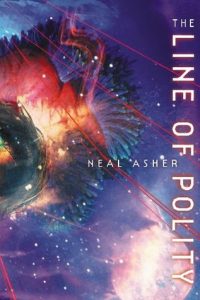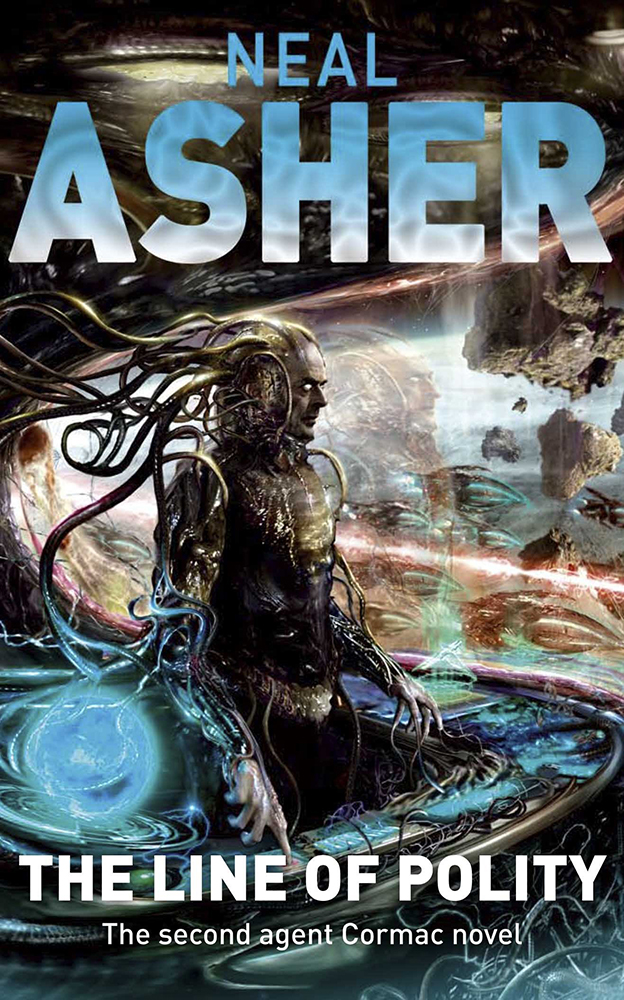The Line of Polity is the second novel in Neal Asher’s Cormac series, preceded by Gridlinked (review) and picking up events a short while after its conclusion. As I approached the Cormac re-read this was the one book I didn’t know how I’d like this time around. When I initially tried to read it I was put off by my view of the setting and somewhat strong religion-bashing theme that is rather heavy handed during the early chapters. However, for my second attempt I managed to put these to one side and I powered through it, enjoying the story that Asher told. This third time, some 6 years after reading it, I was aware of my first impression all that time back, yet I knew that what awaits me after this book pushed me through without any qualms. And I found that there was much more to enjoy than my faulty memory allowed…
From the publisher:
Outlink station Miranda has been destroyed by a nanomycelium, and the very nature of this sabotage suggests that the alien bioconstruct Dragon – a creature as untrustworthy as it is gigantic – is somehow involved. Sent out on a titanic Polity dreadnought, the Occam Razor, agent Cormac must investigate the disaster.
Meanwhile, on the remote planet Masada, the long-term rebellion can never rise above-ground, as the slave population is subjugated by orbital laser arrays controlled by the Theocracy in their cylinder worlds, and by the fact that they cannot safely leave their labour compounds. For the wilderness of Masada lacks breathable air … and out there roam monstrous predators called hooders and siluroynes, not to mention the weird and terrible gabbleducks.
Events in The Line of Polity open with Ian Cormac, Earth Central Security agent, chasing down Skellor, a skilled scientist whose allegiances have always been in doubt, and one that wants to cross the line more often than not in the pursuit of his ideas. As Cormac and his team descend on the compound, Skellor disappears leaving some very interesting things for ECS to discover. Meanwhile the outlink station of Miranda is destroyed by nanomycelium, a product all too familiar to Cormac in that Dragon, a vast alien entity, introduced this to the Polity during the events of Gridlinked.
Then there is Masada, a strictly controlled Theocracy world just past the boundary of the Polity where the inhabitants are ruled with an iron fist by those in power in their orbital stations. Not only that, but Masada is a dangerous world where a human can’t even breath without the aid of gear, where the local wildlife is as dangerous as anything you’d find, and where certain death awaits the workers should they step out of line. But the underground on Masada is trying to gain Polity intervention, something they can only do with a majority vote, and which is slowly being carried out by covert individuals and the underground movement that is desperately trying to push this through.
 Cormac is once again the main character, the central point of the story that brings many things together, and one that gives the reader a good view of events from ECS’ standpoint. However, we also have John Stanton, returning mercenary from Gridlinked who has now settled into life with Jarvellis aboard the Lyric II, trading, carrying, and often smuggling as necessary. With his family connection to Masada and its underground resistance, we get to see a different side to the coin, one that is equally as interesting as that of Earth Central, and one that is key in being able to bring the Polity to the planet. With Skellor added to the mix we have yet a different viewpoint, and one that is not entirely sane in his approach to the situation. Perhaps it has something to do with the Jain technology he’s used to meld with an AI…
Cormac is once again the main character, the central point of the story that brings many things together, and one that gives the reader a good view of events from ECS’ standpoint. However, we also have John Stanton, returning mercenary from Gridlinked who has now settled into life with Jarvellis aboard the Lyric II, trading, carrying, and often smuggling as necessary. With his family connection to Masada and its underground resistance, we get to see a different side to the coin, one that is equally as interesting as that of Earth Central, and one that is key in being able to bring the Polity to the planet. With Skellor added to the mix we have yet a different viewpoint, and one that is not entirely sane in his approach to the situation. Perhaps it has something to do with the Jain technology he’s used to meld with an AI…
Some of the big plus sides for me in The Line of Polity are the technologies that Asher introduces and explores – golems, AI, Polity starships, intelligent weapons and, well, pretty much everything you find on Masada. These things really do help the worldbuilding of the Polity, showing us much more than is needed for the story, yet keeping it relevant. The Masadan environment is brutal and the native creatures deadly, all of which builds a place you seriously would not want to visit – but reading about it is huge amounts of fun.
While I did enjoy The Line of Polity this time around, one aspect still grates at me: the anti-religion stance Asher presents. The Theocracy work exceedingly well in the story, they are evil and rule the lower classes with no regard to their wellbeing. There is also the clear disparity between those at the bottom and those at the top – the higher up you get, the more they can do without being tied to their stricture. I’m not a religious person, so this is not about taking offence to the presentation of religion in this way, more that it comes across a little too heavy handed at times. However, it does work within the confines of the story, and it’s the type of situation which could easily arise given the nature of the Polity.
Overall I enjoyed The Line of Polity enough not to let that one issue affect my feelings about the book too much. It’s got more of Asher’s hallmarks present that we didn’t entirely see in Gridlinked, in the weird and lethal wildlife of Masada. It’s also, in hindsight, one of the more important books in Asher’s Polity milieu (for reasons/spoilers that I won’t go into here). With a good focus on both the big picture and events on the ground it’s hard to fault much, though the distinct lack of answers from the end of Gridlinked still lingers. Regardless, a solid entry in the series and a damn good SF novel. Recommended.
Publisher: Tor UK
Author: Neal Asher
October 2009 (re-issue), 672 Pages
Paperback, ISBN: 9780330512565
Review from purchased copy
© 2017 Mark Chitty | @chitman13





